Milan: A travel guide for music fans
Visit destinations for classical music and opera art with a historical connection. Get to know exciting ideas and background information
1
LIFE AND WORK OF COMPOSERS IN MILAN
Read about the fates of famous artists in the opera capital of Italy.
1
2
CONCERT AND OPERA HOUSES IN MILAN
Read about Scala’s illustrious history.
2
3
CHURCHES
Even Mozart was there
3
4
MUSEUMS
The Museum of La Scala: a must for opera fans.
4
5
HOUSES AND APARTMENTS BY ARTISTS
Where Callas and Mozart lived
5
6
GRAVESITE OF FAMOUS MUSIC ARTISTS
The Cimitero Monumentale: Milan’s Monumental Cemetery. But the greatest of them all does not rest there
6
7
HOTELS, RESTAURANTS AND SPECIALITIES
Where to stay in the footsteps of Verdi, visit Callas’ favorite place and learn about a Milanese specialty
7
8
MUSICAL PIECES RELATING TO MILAN
How two famous operas failed in their premiere at La Scala
8
LIFE AND WORK OF COMPOSERS IN MILAN
Vincenzo Bellini
The collaboration with the librettist Romani
Milan was Vincenzo Bellini’s most important artistic station. The impresario Barbaja arranged the contact with the main librettist of La Scala, Felice Romani, who, with the exception of “I Puritani”, was to write all of Bellini’s subsequent libretti.
Felice Romani:
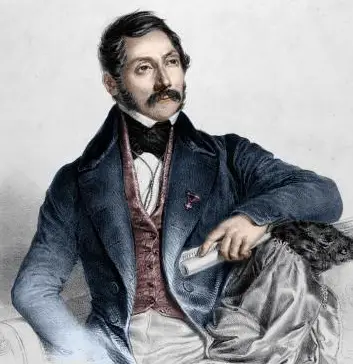
Triumph and defeat
The first opera “Il pirata” hit Milan like a bomb and Bellini wrote six operas for La Scala and the Carcano in the next 4 years. In Milan he also came into contact with 2 of the 3 Giudittas who played an important role in his life. On the one hand, it concerned the affair with the married Turina (which was blown up because of an intercepted letter) and, on the other hand, the artistic (and probably private) partnership with the famous Giuditta Pasta.
Bellini moved skillfully in the aristocratic Milanese salons and quickly created a network of relationships. However, this did not protect him from the greatest disgrace of his career, the scandalous premiere of his “Norma” at La Scala (more about this in the excursus at the end).
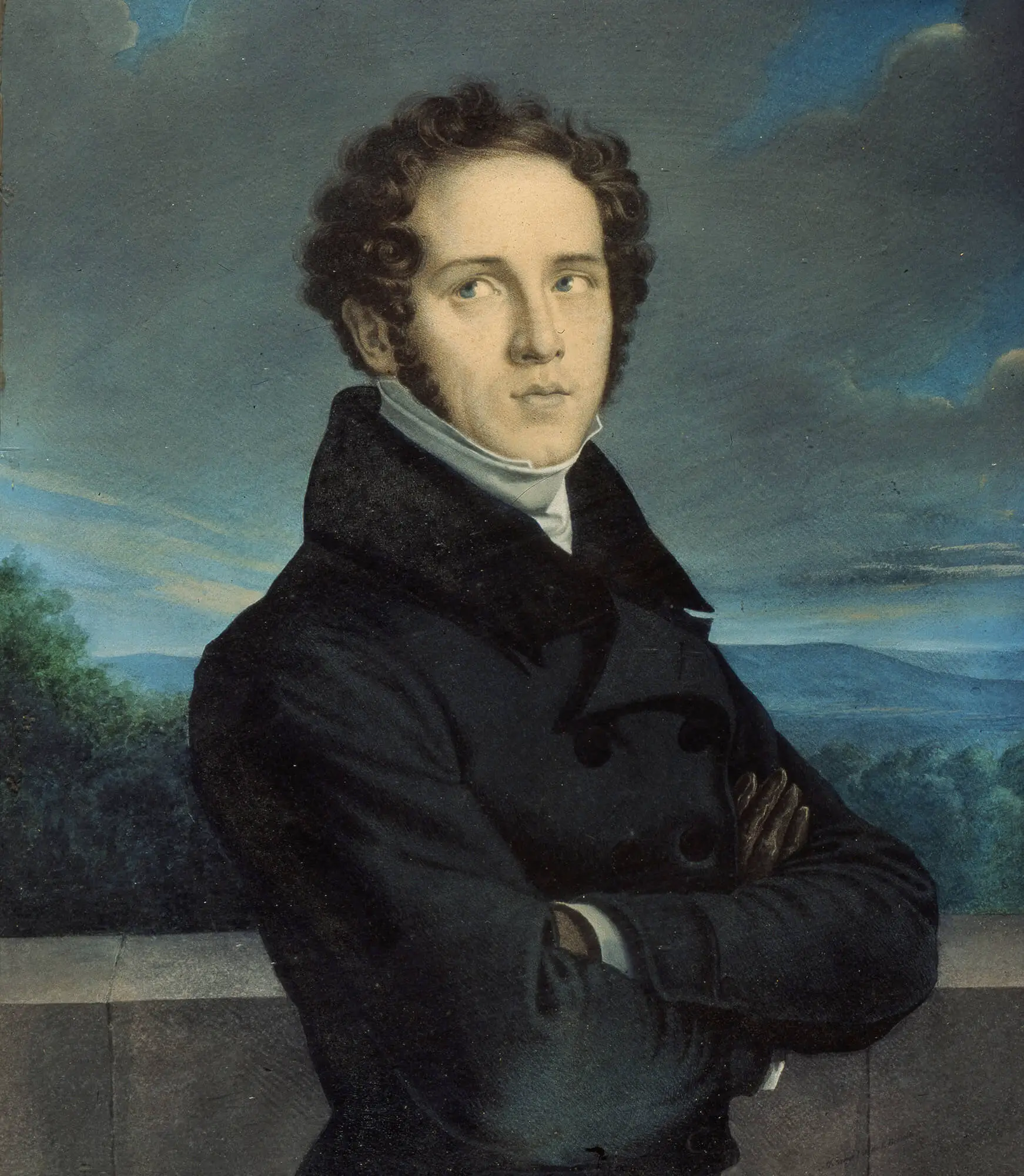
Maria Callas
Battle for the Queen’s Realm of La Scala
In 1950 Maria Callas had sung at La Scala for the first time and she became the “prima donna assoluta” of La Scala in the 1950s.
But she had to fight for this position. When she came to La Scala, Renata Tebaldi occupied this position, enthroned as the “angel’s voice” at the reopening of La Scala in 1946 by Toscanini. What followed was not only artistic competition but also personal animosity. Tebaldi captivated with her angelic voice, Callas with her dramatic expression and stupendous technique. The claques of the two singers did their part to fuel the rivalry. Eventually Callas gained the upper hand and Tebaldi focused on the Met, and so both singers got their queen realms.
Callas’ relationship with audiences and management was never free of tension, however; perhaps the magnitude of her importance was only realised in retrospect, for many of the greatest performances and most of the great recordings were made at La Scala. The last performance was in 1962, with over a decade of emotion in between.
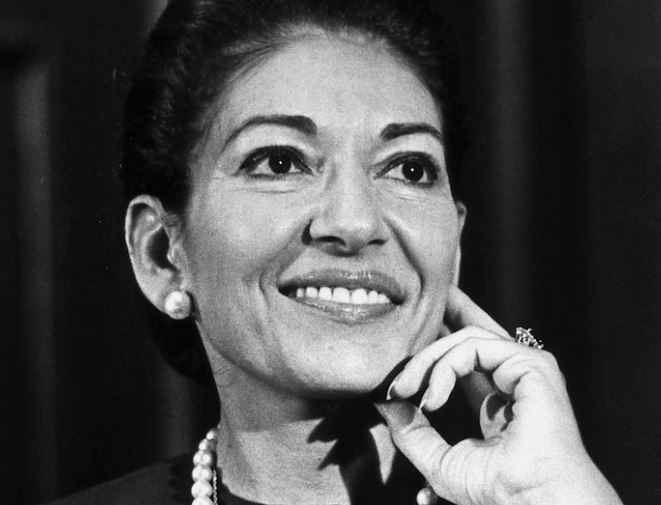
Gaetano Donizetti
Career kick in Milan
Milan played a minor role in Donizetti’s personal biography alongside Bergamo, Naples and Paris. And yet the northern Italian metropolis was decisive for the career of the Lombard. In 1830 his international career began there with the triumph of his first masterpiece “Anna Bolena” starring the dream couple Giuditta Patsa and Giovanni Rubini.
Two years later he presented himself to the Milan audience with “Elisir d’amore”. When the opera premiered on May 12, 1832, Donizetti experienced one of the most brilliant moments of his career. The ovations from the audience were gigantic, and the reviews in the newspapers were overwhelming. Donizetti thus brilliantly confirmed the success he had achieved with “Anna Bolena” two years earlier. Now he was finally on a par with his friend and rival Bellini, and the two became Italy’s leading opera composers.
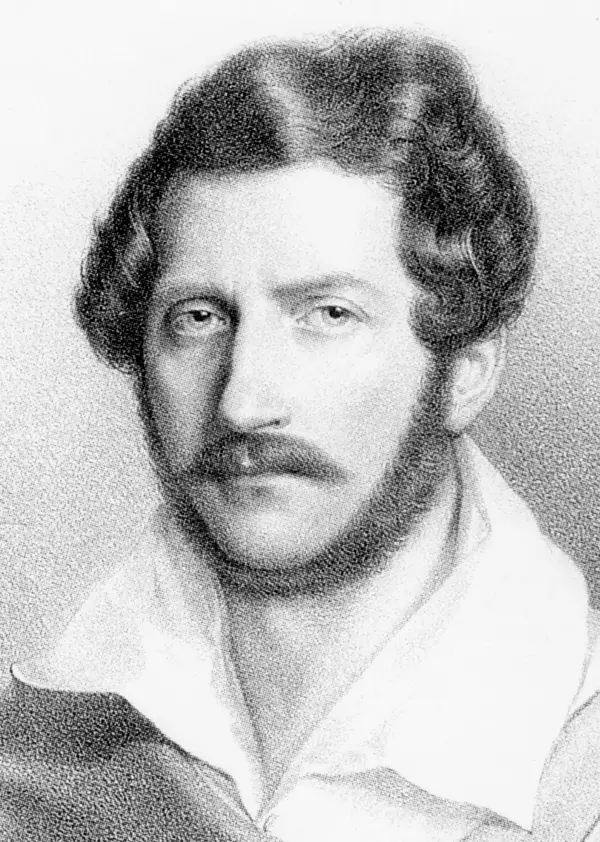
TO THE COMPLETE DONIZETTI BIOGRAPHY
Wolfgang Amadeus Mozart
Triumph as a 14-year-old with an opera
In January 1770, father and son Mozart arrive in Milan. After the hardships of crossing the Brenner Pass in snow and cold, the two hope for a lucrative commission.Mozart takes lessons from the old Sammartini and is allowed to perform in public several times. The commission arrives and Mozart receives a libretto for “Mitridate re di Ponte”.
In the autumn they return with the finished opera. The 14-year-old Mozart conducts the first three performances himself and the Milanese are over the moon, ensuring sold-out performances for months. Mozart returns twice more with operas for Milan (“Ascanio” and “Lucio Silla”) until Archbishop Colloredo in Salzburg stops the commissions. All three performances took place in the Pallazio Regio Ducal, which burned down three years after the premiere of “Lucio Silla”. Next stop on the Italy tour is Bologna.
TO THE COMPLETE MOZART BIOGRAPHY
The 14-years-old Mozart:
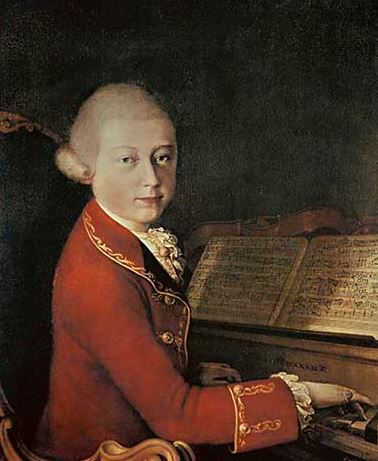
Giacomo Puccini
Many points of contact with Milan
Two successful premieres in Milan frame Puccini’s artistic life. First the one-act opera “Le Vili” at the Teatro Verme in 1884 and 40 years later the posthumous premiere of “Turandot” at La Scala. Both performances were successes, the former the respect success of the newcomer and the latter the homage to the monument of Puccini, who with Turandot had given birth to his last giant. In between, however, Puccini had more than once quarreled with Milan, more precisely with La Scala, see also the digression on the premiere of “Butterfly” at La Scala below.
For him, Milan also meant the mouse-poor student years at the Milan Conservatory, where he shared a room with Pietro Mascagni, among others. He recalled these years fondly in “La Bohème.” As a composer, Milan was also important to him because it was home to the branch of his publisher Ricordi, with whom he had completed all but one of his opera projects (La Rondine).[/sc_fs_faq]
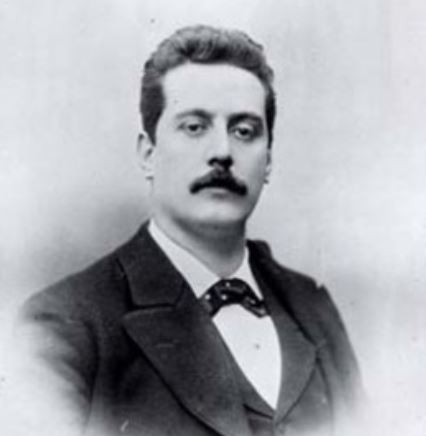
TO THE COMPLETE PUCCINI BIOGRAPHY
Gioachino Rossini
Successful works between the ages of 18 and 25.
The years 1810-1820 were Rossini’s galley years, during which he wrote over 30 works for a dozen theaters. Yet in Rossini’s biography, Milan was overshadowed by Naples, Bologna and Paris. Nevertheless, the Lombard capital saw the premieres of half a dozen of Rossini’s works, including “Gazza ladra” and “Il turco in Italia.”
The famous partnership with Barbaja
Rossini met Domenico Barbaja there, who was in charge of the “entertainment center” at La Scala. The Scala of Rossini’s time must be imagined somewhat differently than we are used to nowadays. While the music was important, the social aspect of a visit was at least as important. Scala also included a café, a pastry shop, a kitchen, and game rooms. The resourceful Domenico Barbaja was responsible for the latter. With the French coming to power during the Napoleonic years, gambling was legalized and Barbaja turned La Scala into an entertainment center with music, gastronomy and gambling.[/sc_fs_faq]
TO THE FULL ROSSINI BIOGRAPHY
The young Rossini:
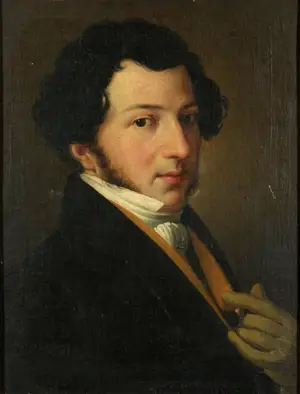
Giuseppe Verdi
A lifelong relationship with La Scala
Throughout his life, La Scala in Milan was Verdi’s most important artistic reference point. The premiere of his first opera (Oberto) took place in this theater in 1839, and 54 years later also that of his last opera (Falstaff). In addition, the offices of his lifelong publisher Ricordi were located in Milan.
His career really took off at this theater with the sensational success of “Nabucco” in 1843, whereupon the impresario Merelli offered Verdi a contract for a follow-up work. The contract was completely worked out, with only a gap in the compensation sum. Merelli, the impresario of La Scala, asked the composer to insert the sum he liked himself.
Verdi in front of La Scala:
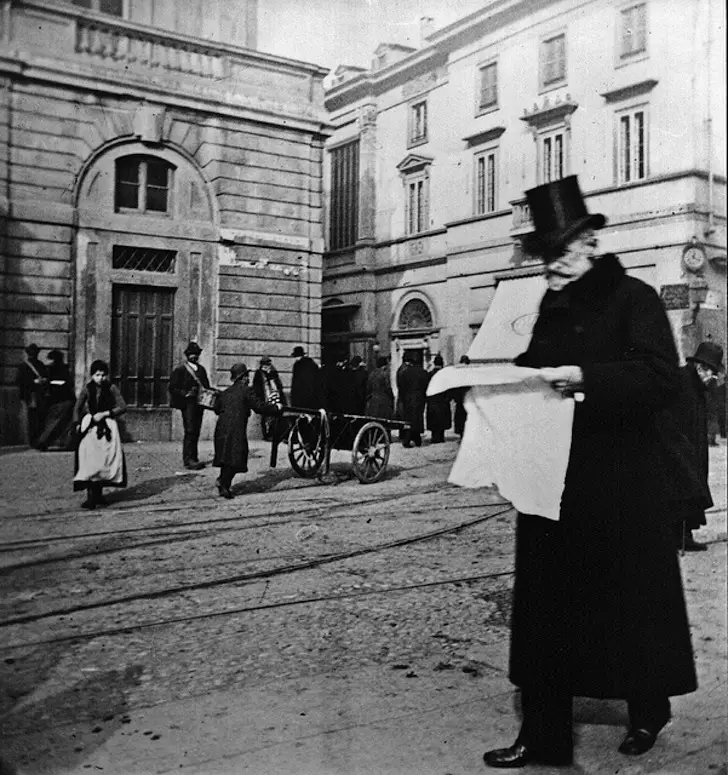
Death and funeral in Milan
After his wife Giuseppina died in 1897, Verdi often spent his remaining time in his suite at the Albergo Milano (now the Gran Hotel), where he died in his room in 1901. Modestly, according to his wishes, his body was taken to the cemetery for burial in a III class carriage. It was not until three weeks later that his body was transferred to the crypt of the Casa di riposo with the enormous participation of the Milanese population, accompanied by the singing of the estimated 300,000 people along the route who spontaneously sang “Va pensiero”. His death suite at the Gran Hotel has been preserved to this day and can be booked.
LINK TO THE COMPLETE VERDI BIOGRAPHY
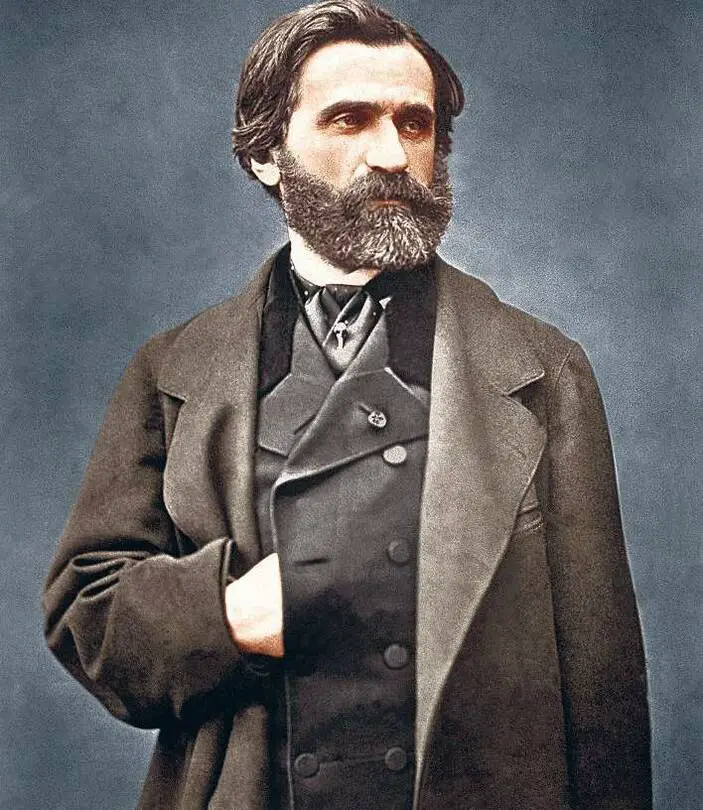
OPERA HOUSES IN MILAN
Teatro alla Scala I
Built in record time
The Scala was built in 1778 under Austrian rule in a record time of 2 years, as the previous building had burned down. It got its name from a church with a monastery on the site, which held that name. The auditorium is made of wood covered with velvet and thus has excellent acoustics.
In the following 150 years La Scala became the place of many important premieres of composers like Gioachino Rossini, Vincenzo Bellini, Gaetano Donizetti, Giuseppe Verdi and Giacomo Puccini.

In 1943 it was badly damaged by bombs and opened with a glorious concert conducted by Toscanini. A soprano solo by the still unknown Renata Tebaldi became a sensation.
Originally the theater had 3000 seats, many of them in the 600 boxes. Today there are still 150 boxes and 2300 seats. Above the boxes are the seats of the Logionisti, the notorious, uncompromising visitors, who have brought many an established star to fury with boos.
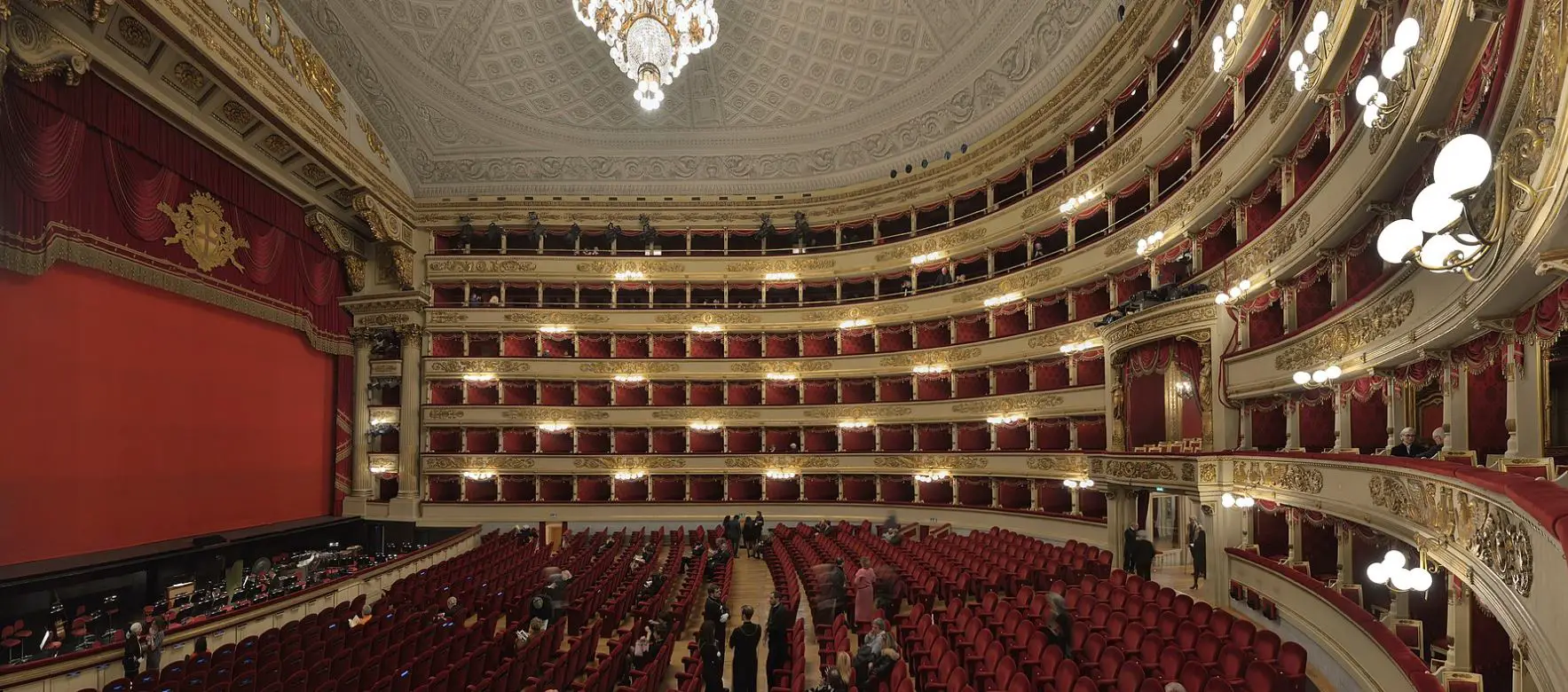
Teatro alla Scala II: Honoring composers and artists
Rossini became one of the most important composers for La Scala early on, his name was enough to fill the theaters. La Scala honored Rossini with a large statue in its premises.
Rossini’s Statue in the Scala:
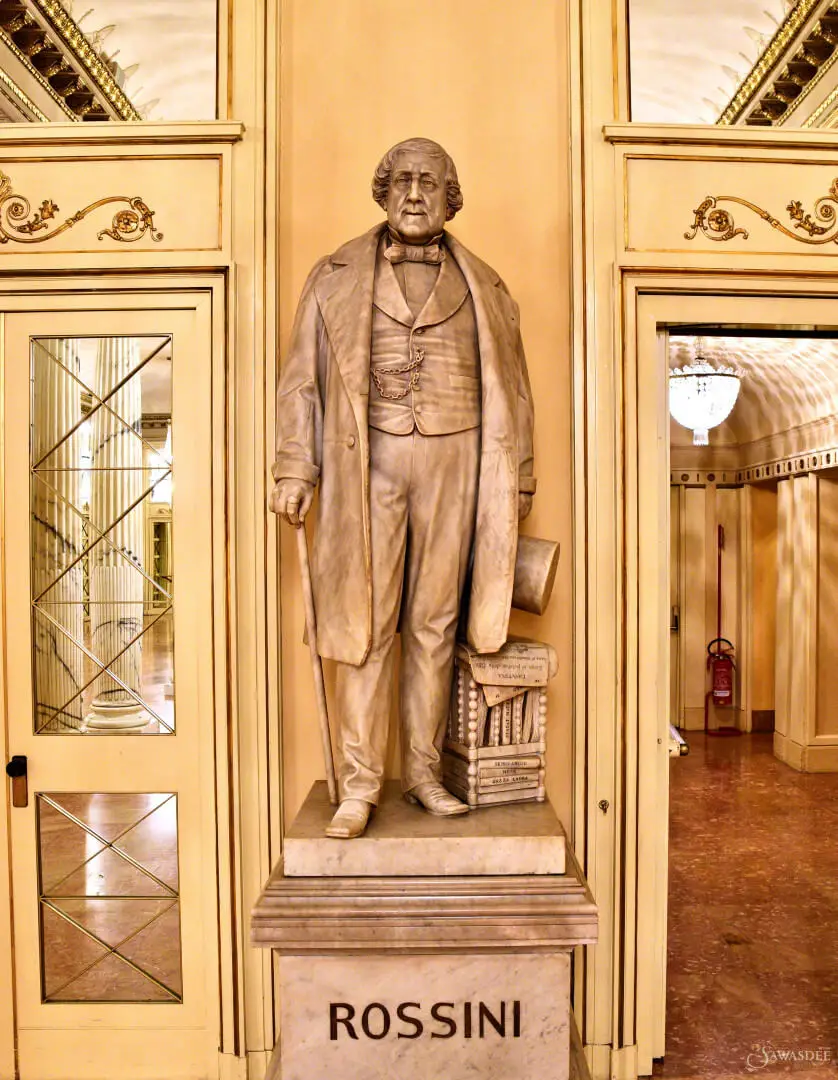
5 of Donizetti’s 71 operas were premiered at La Scala. Among them was his “Lucrezia Borgia”. This piece struggled with censorship in the 19th century and was performed with 6 different titles in its first 10 years; in 1845 in Paris, Italians even became Turks (“La rinnegata”).
La Scala honored Donizetti with a statue in the foyer of the theater.
Donizetti’s bust in the Scala:
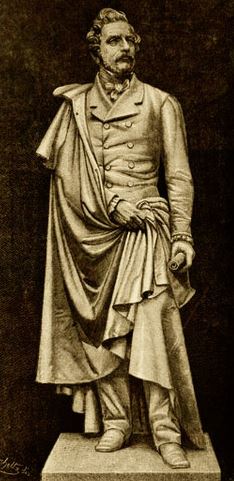
Toscanini had an eventful time at La Scala. He experienced La Scala as a cellist and got to know Verdi. He had an artistic partnership with Puccini. With the rise of fascism, he refused to play at La Scala its anthem, the Giovinezza, and left Italy and La Scala. It was he who, 20 years later, as the Immaculate, had the honor of gloriously opening La Scala, which was reopened and renovated after the war.
Toscanini’s bust in the Scala:
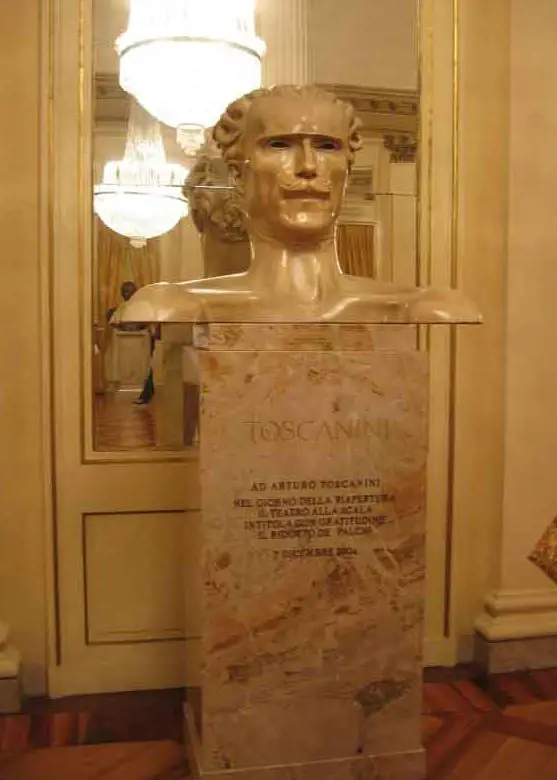
Teatro alla Scala III: Puccinis difficult hours at La Scala
Two operas were premiered at La Scala during Puccini’s lifetime, both of them failed there. The premiere of Butterfly even became the most bitter moment of Puccini’s career, read more about it in the digression below. Only the premiere of Turandot became a triumph, but Puccini did not live to see it. Many of Puccini’s works are still among the most performed at La Scala today.
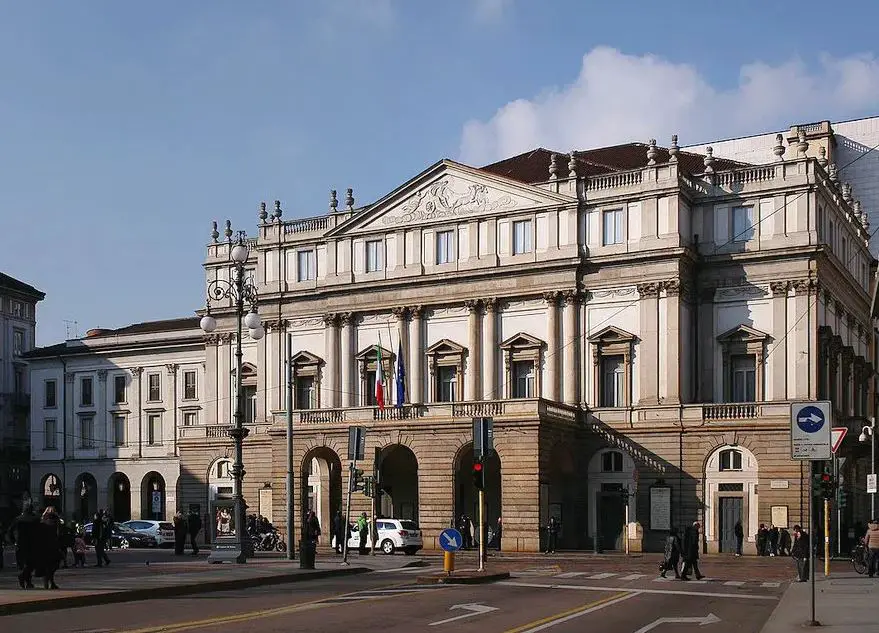
Teatro alla Scala IV: Maria Callas
The famous “punto Callas”
La Scala was the artistic center of the most important opera singer of the 20th century. The severely myopic Callas knew La Scala acoustically like the back of her hand and had a point on stage where her voice could develop the best acoustic effect, the so-called “punto Callas”. Where this point was located is disputed.
The stage:
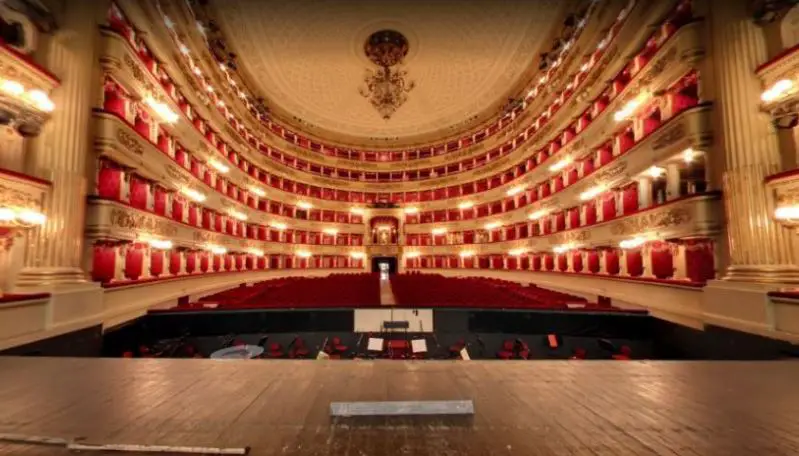
Teatro alla Scala V: the high C
The high C of Verdi’s “di quella pira”
The opera house is still a central cultural place of Milan and still makes the hearts and blood pressure of the Italians rise higher, as the following story about Verdi and the high C proves: The famous aria “Di quella pira” from “Il Trovatore” is usually concluded with a high C. Interestingly, Verdi did not compose a high C at this point. Enrico Tamberlinck, one of the first Manrico had explicitly asked Verdi for permission. The maestro had explicitly allowed it, on the condition that the C would also be sung beautifully. Thus this convention has prevailed and most listeners know the aria only in this way; following the original low note of the score would cause irritation, if not disappointment, in the audience.
The controversy
Even Toscanini, who forbade any liberties taken by singers in the 19th century, accepted the convention. In 2000, for the celebrations of the 100th anniversary of Verdi’s death at the opera house “La Scala” in Milan, Riccardo Muti, the conductor and artistic director of La Scala, ordered that this aria be sung in the original version, that is, without the high C. After the aria there was a hail of boos and the result was a real theater scandal that moved the press and the minds for days.
Teatro alla Canobbiana (today Teatro lirico)
Site of the premiere of “Elisir d’amore”
This theater was the premiere site of his “Elisir d’amore”. Donizetti wrote the opera in an incredible 13 days. The time pressure stemmed from the fact that a composer at Milan’s Teatro alla Canobbiana (the city’s popular second theater, along with La Scala) was unable to complete his commissioned work in time, and the theater therefore needed an alternative at short notice. It is interesting to see Donizetti’s autographs of the “Elisir”, because Donizetti wrote out only the vocal lines, in addition he noted the bass lines to indicate the harmonic progression. To this he added remarks on how to orchestrate. The copyist then wrote out the parts and completed the score under Donizetti’s supervision. Hector Berlioz attended one of the first performances of the opera, and he was not very complimentary about the theater business at that time. He had to strain to hear the music above the din of the audience. People were talking to each other, gambling for money, dining, and successfully drowning out the orchestra.
The Canobbiana was renamed the “Teatro lirico” in 1894 and has had a troubled history since then, including a fire in 1937. A renovation has been underway for several years. The opening is planned for 2021 or 2022.
After the devastating fire in 1937:
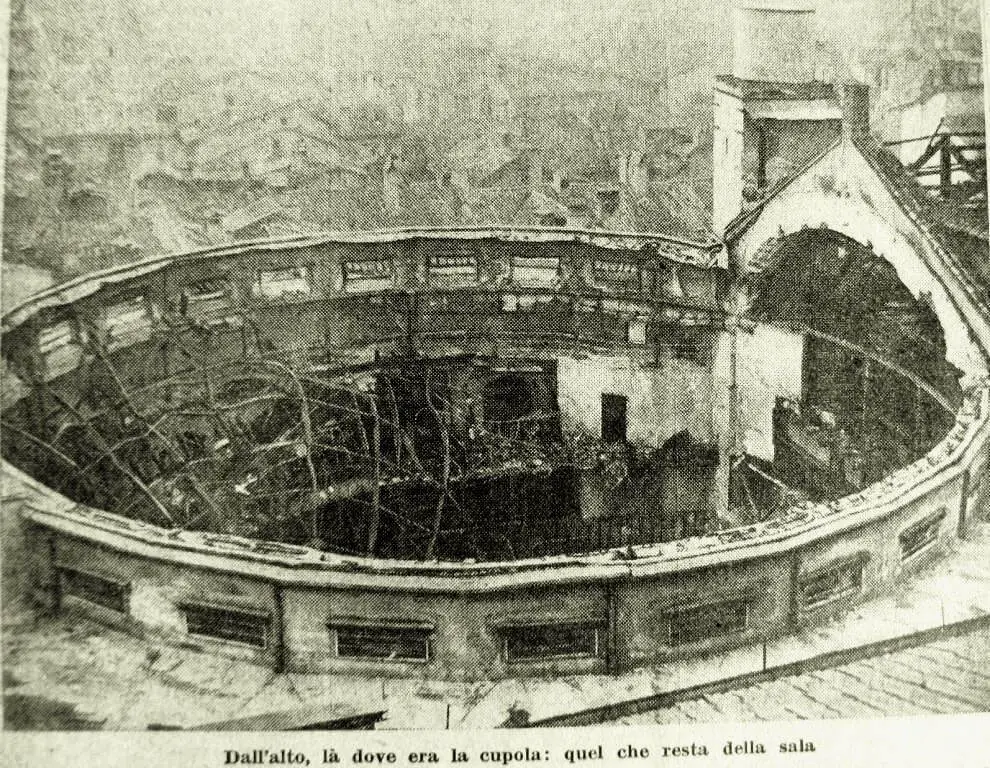
CHURCHES
Chiesa San Marco I
World premiere site of Verdi’s Requiem
Deeply shaken by Rossini’s death, Verdi wanted to persuade various musicians to write a Requiem for the national saint in 1868. Verdi wrote a final movement, but the work did not materialize. Fifteen years later, at the death of the artist and inspirer of the Risorgimento, Alessandro Manzoni, Verdi took the reins himself and wrote his famous Requiem for a memorial service that was finally held in the church of San Marco a year after Manzoni’s death. Verdi did not attend the first performance, but conducted another performance of this massive work a year later at the same venue.
Campanile of the Basilica San Marco:
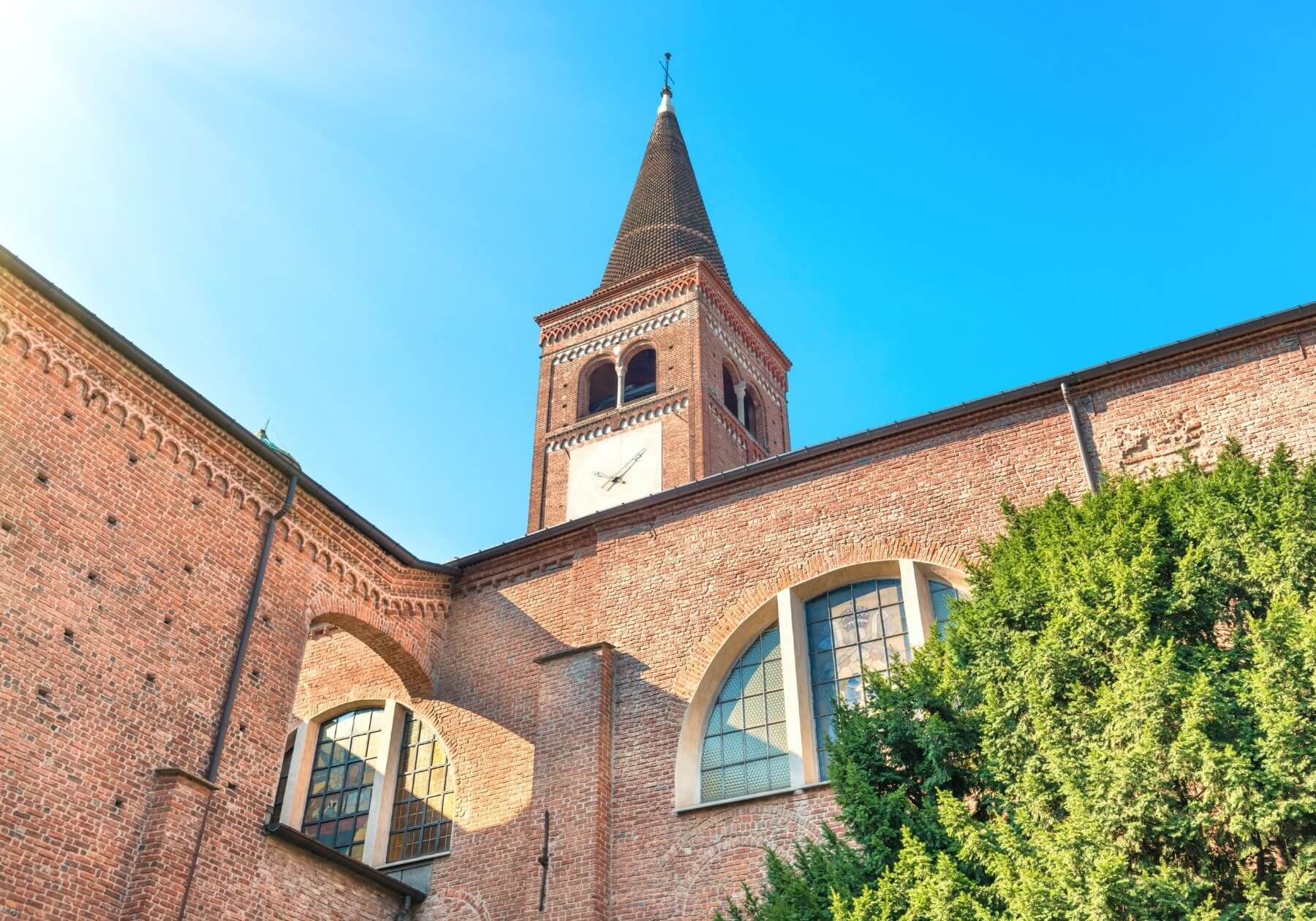
Chiesa San Marco II
Visited by Mozart
In this church Mozart played for the first time in front of a larger audience on one of the oldest organs in Lombardy. The church is definitely worth a visit and has, among other things, very beautiful frescoes. It was built in 1254 and was visited by Martin Luther, among others. Another beautiful church, frequented by Mozart, is the Chiesa di Sant’Antonio Abate.
Frescoes in San Marco:
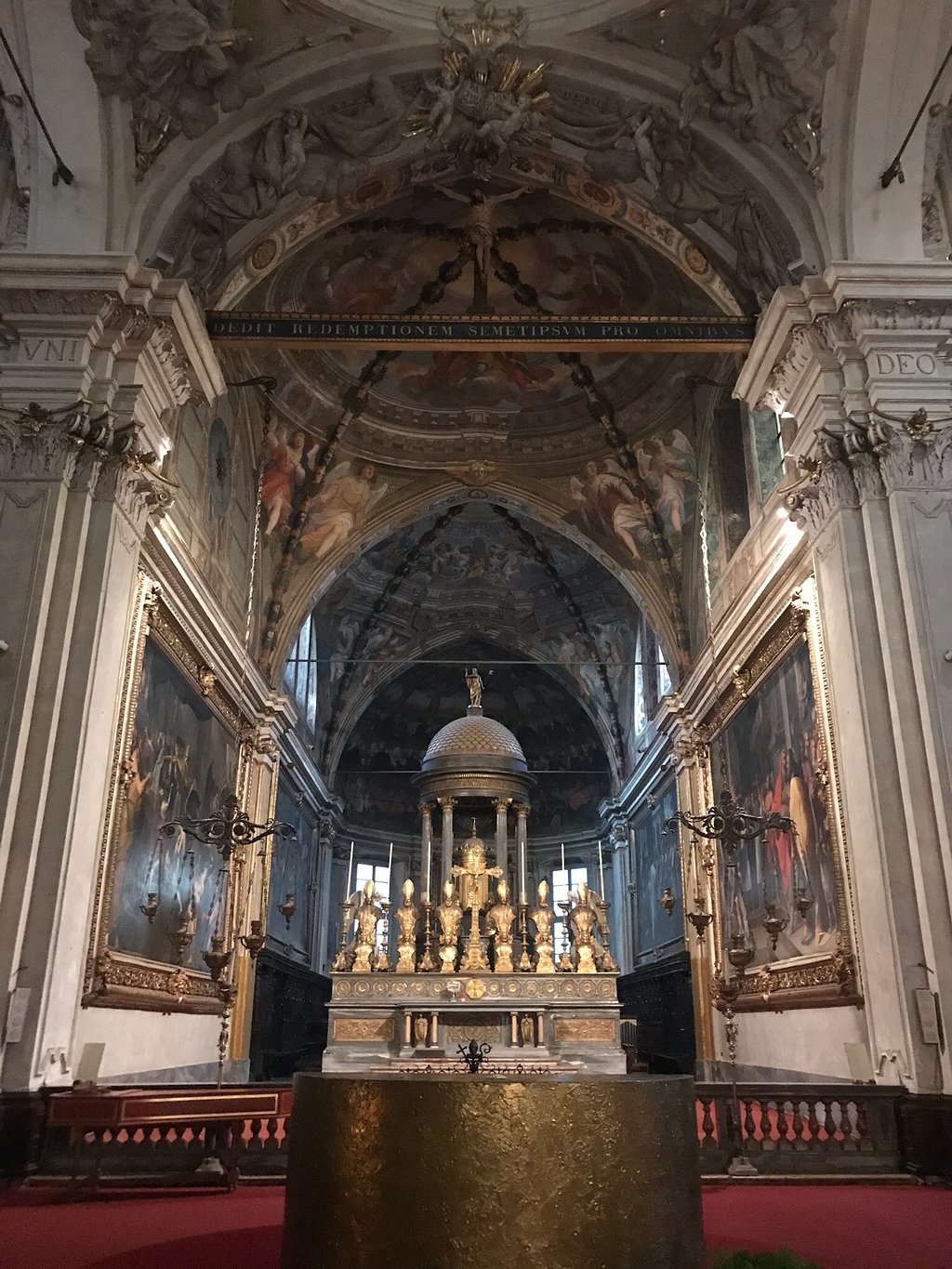
Monday and Thursday are days of market on the square
Milan Cathedral (Il Duomo)
The Duomo of Milan is gigantic and the third largest church in the world. The roof terrace of the cathedral can be walked on and offers a great view over Milan.
Toscanini’s farewell to Puccini
In 1924, Arturo Toscanini conducted the funeral ceremonies for the late Puccini in Milan Cathedral. Toscanini bore a heavy burden, for 23 years earlier he had conducted the ceremonies for Verdi, and now it was his friend and companion Puccini’s turn. The speech was given by none other than Benito Mussolini, who tried to exploit the death of the now national saint politically.
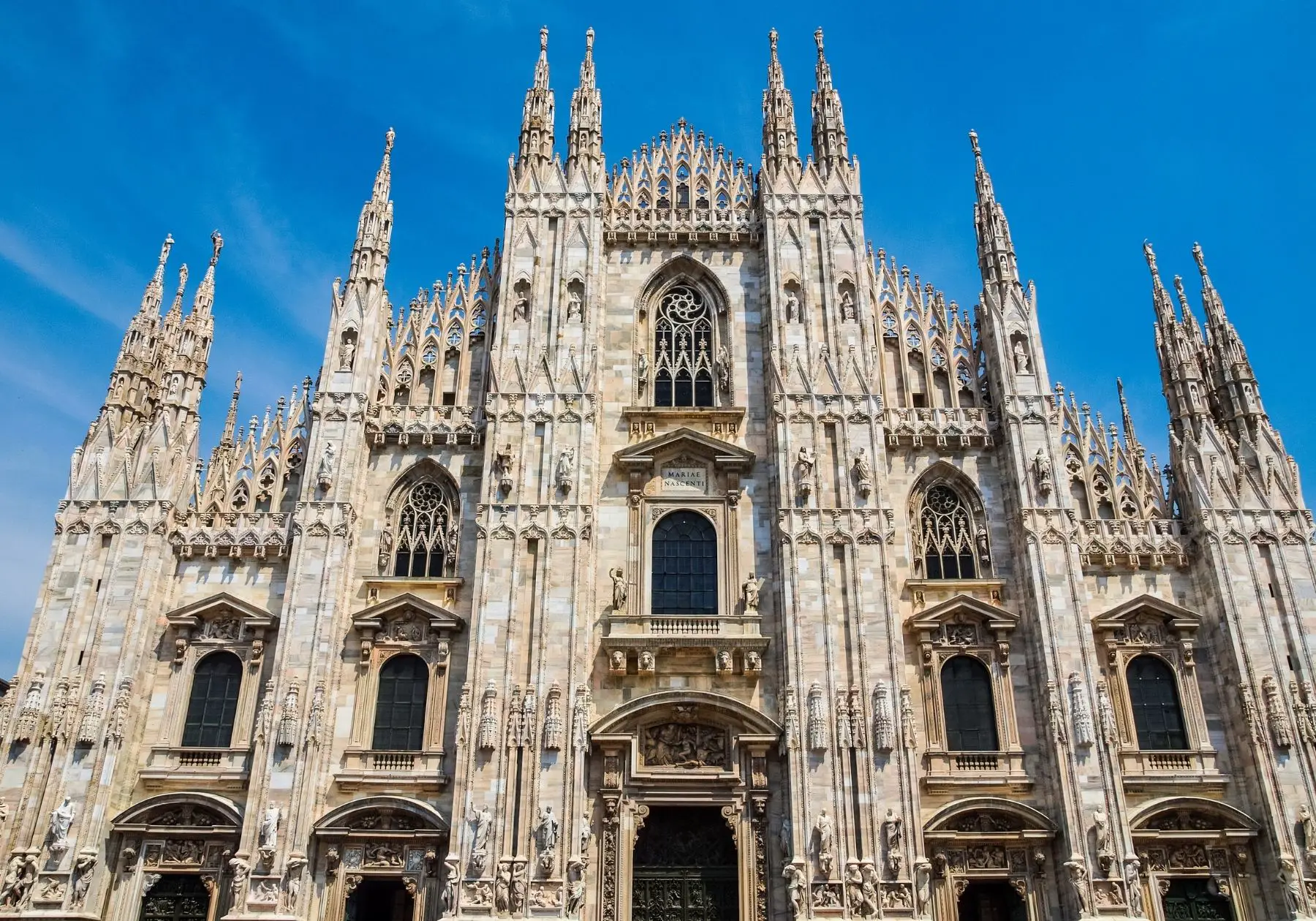
MUSEUMS
Museo teatrale alla scala I
The museum of the opera house
In the interesting theater museum next to La Scala you can find many exhibits such as costumes, paintings, etc. During the visit you can usually also enter boxes and take a look inside the theater hall. In the exhibition room 4 you can find a well-known portrait of Verdi by Scalese and the autograph of the famous chorus “Va pensiero” from “Nabucco”.
Verdi painted by Scalese:
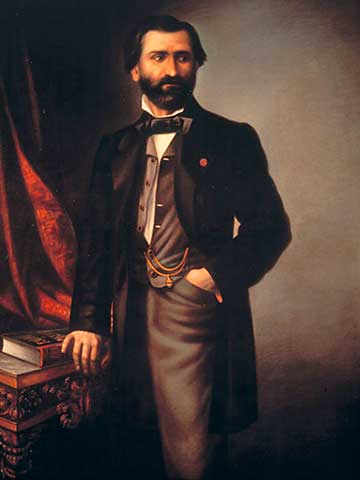
Museo teatrale alla scala II
The museum of the opera house
In this museum is the famous portrait of Bellini by Carlo Arienti, painted in Milan in 1831.
Painting of Bellini:

Museo instrumenti musicali in Castello Sforzesco
Lovers of older classical instruments will find a paradise with over 700 musical instruments on display from the 16th to the 20th century, including plucked instruments, violins from Cremona, flutes and even a spinet on which Mozart is said to have played.
Museo degli instrumente musicali:
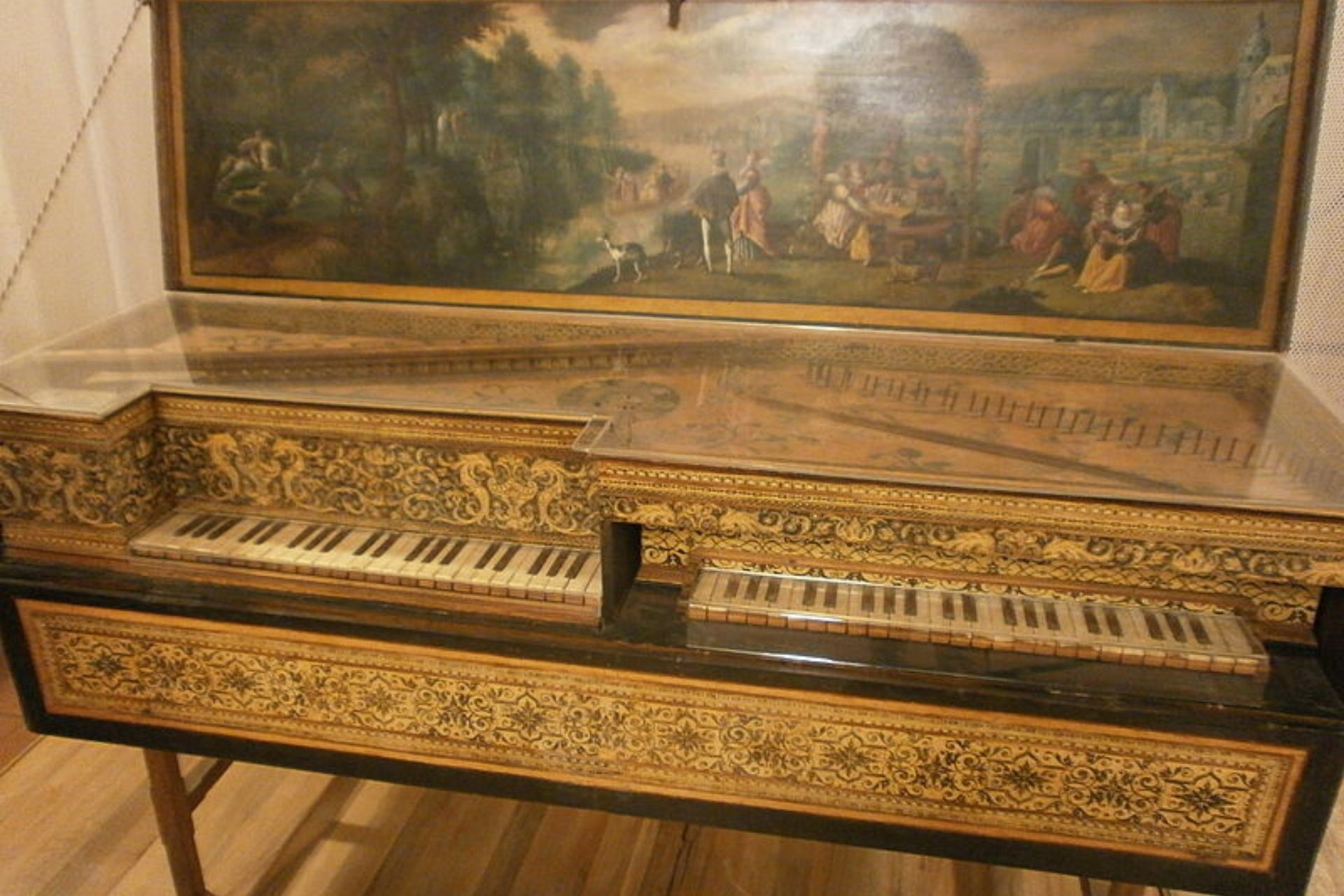
HOUSES AND APARTEMENTS
Apartment in Milan of Maria Callas
From 1952, Maria Callas and her husband Meneghini lived in the top-floor city apartment at 38 Via Buonarotti when she was in Milan (they owned a house in Sirmione). At the end of the 50’s Aristotle Onassis was also seen there. Today, a plaque still commemorates the famous inhabitant of the house.
Callas in the appartement at Via Buonarotti:
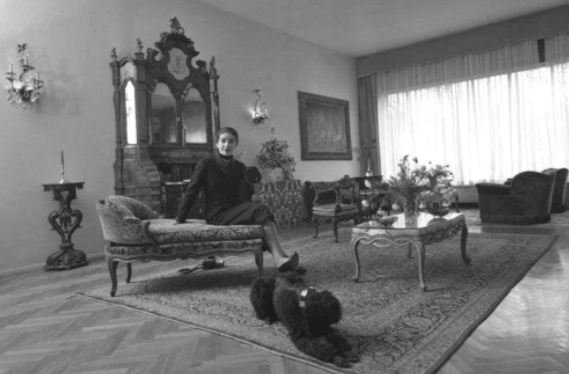
Mozart residence in Milan
In this palazzo Mozart was a frequent guest of a family of silk manufacturers. He also had the honor of inaugurating the music hall. However, this spectacular palace can be visited only on a limited basis, exclusively with guided tours. From the outside the palazzo looks inconspicuous, from the inside it is spectacular with a grand salon and frescoes by Tiepolo. At present it is the seat of the ISPI with offices.
Arrange tours well in advance, before the start of your trip.
Palazzo Clerici:
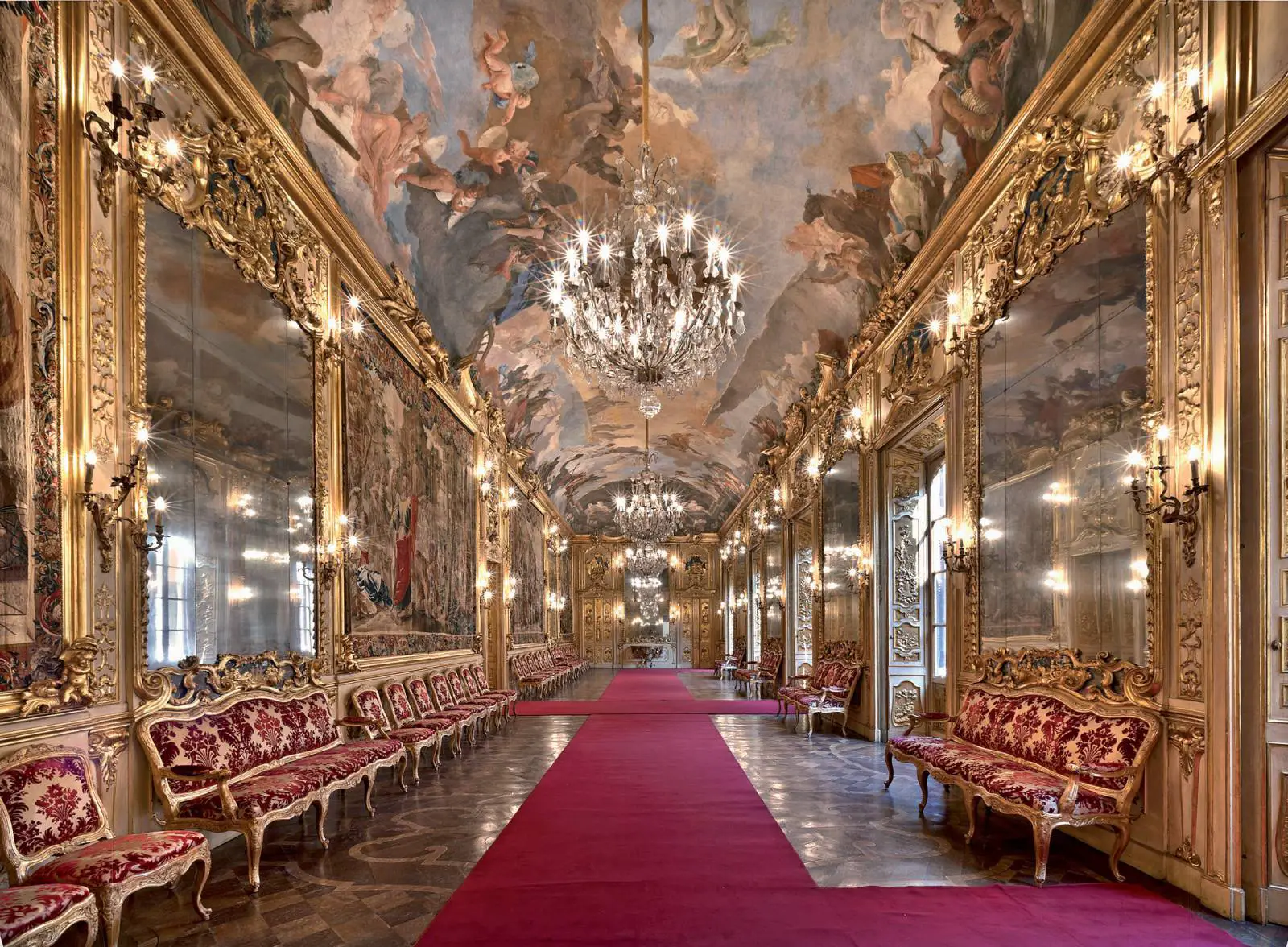
GRAVESITES OF FAMOUS MUSICIANS
Casa Verdi: Giuseppe Verdi
Tomb in the Casa di riposo
In the last years of his life, Verdi initiated a generous deed. He bought a large area at the Piazza Buonarroti and had a rest home built there for impoverished, old musicians. He deliberately did not want to build a hospital-like nursing home, but a home for guests who were to live in 2-person rooms instead of dormitories. Since then, more than a thousand people have enjoyed this tastefully furnished boarding house, which, at Verdi’s request, was opened only after his death. He supervised the work meticulously and spoke “of his most beautiful work” (‘mia piu bella opera’). The garden with the crypt of Verdi and his wife Giuseppina is accessible by appointment at the reception, more (concert hall, Turkish room and many interesting memorabilia) depends on the events of the day.
Casaverdi:
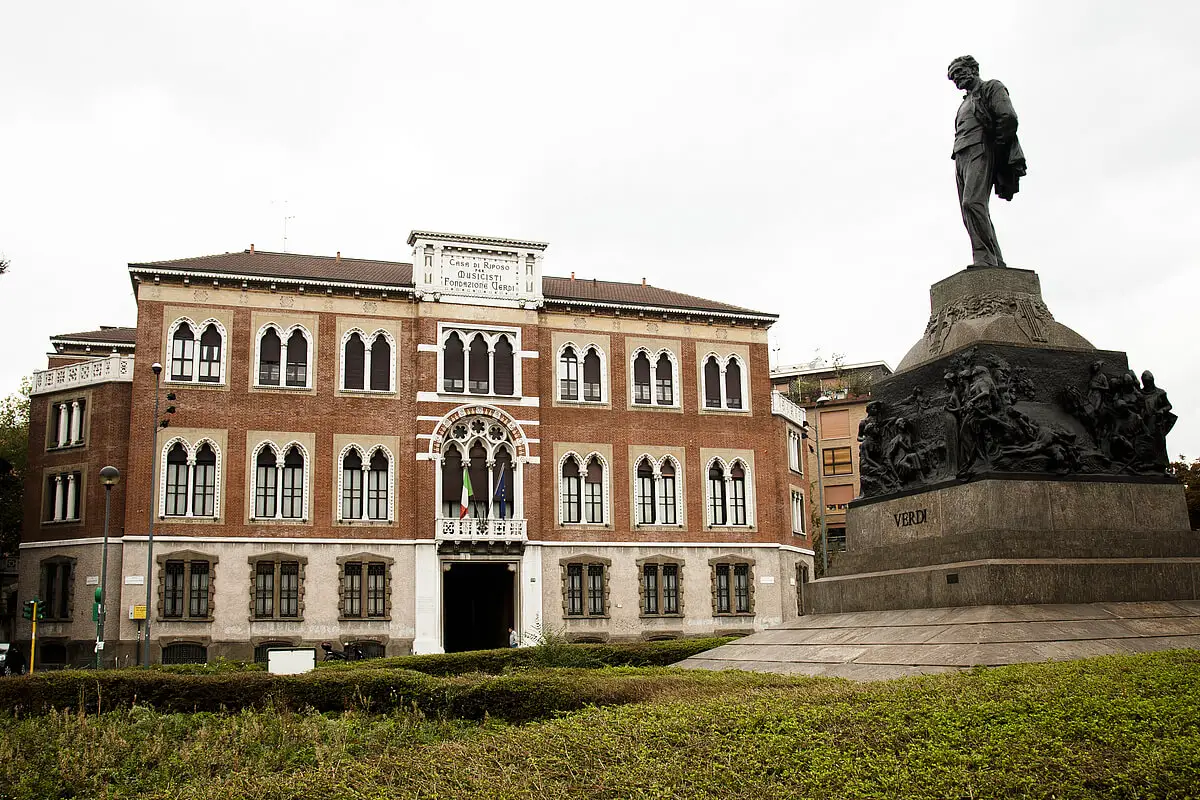
Gravesite:
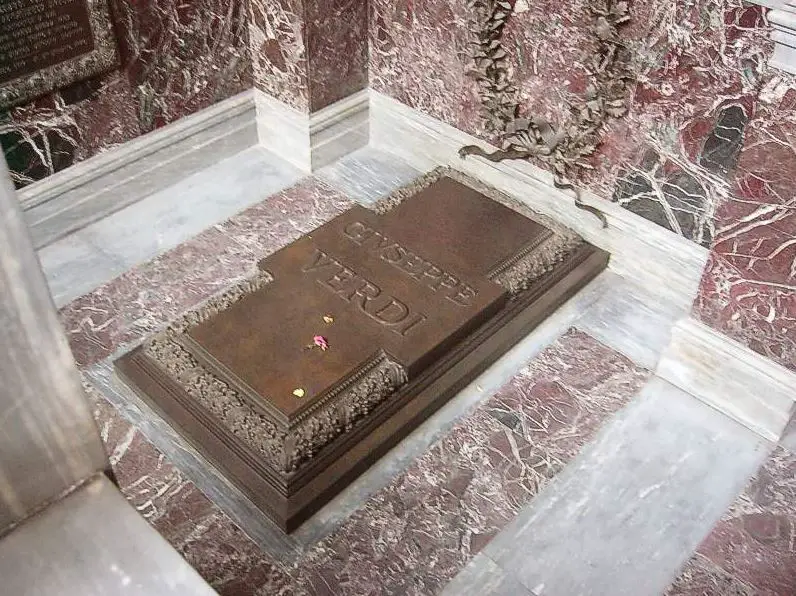
Cimitero monumentale: Arturo Toscanini
Toscanini died in New York in 1957 at the age of 90. He was taken to Italy, where a ceremony was held at La Scala.
On this Carrara marble block you can see 3 Norns holding the threads of fate in their hands.
Finally, on the reverse side, one sees a naked man and a naked woman: they embrace each other in pain. Between them is the inscription in memory of the little Giorgio Toscanini , who died in June 1906 at the age of barely 5 years, the youngest son of Arturo Toscanini.
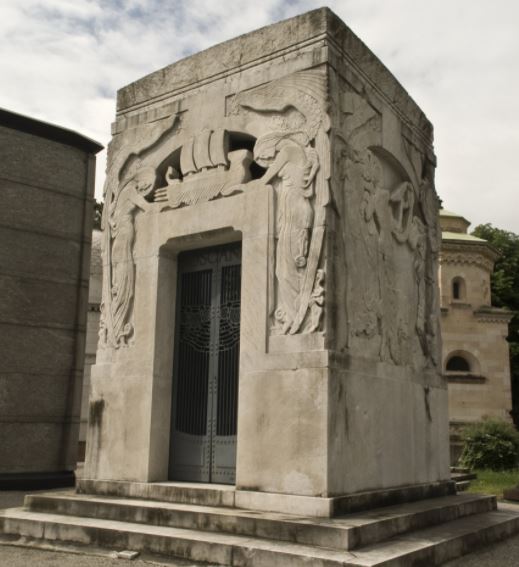
Cimitero monumentale: Vladimir Horowitz
Vladimir Horowitz, the famous pianist, was the son-in-law of Arturo Toscanini and was buried with his wife Wanda in Arturo Toscanini’s family vault.
He died of a heart attack in 1989 at the age of 86.

Cimitero monumentale: Arigo Boito
Arigo Boito was a writer and musician. Among other things, he wrote libretti for Verdi (Simon Boccanegra revision, Otello, Falstaff) and wrote the famous opera “Mefistofele”.
Boito with Verdi:
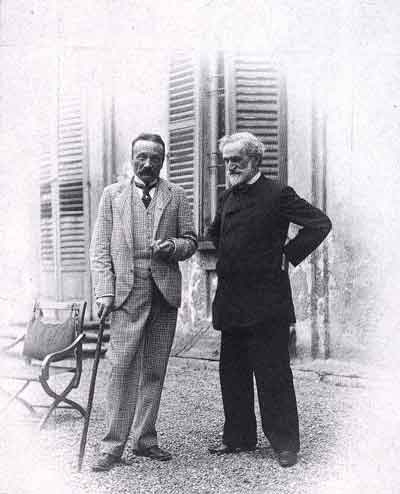
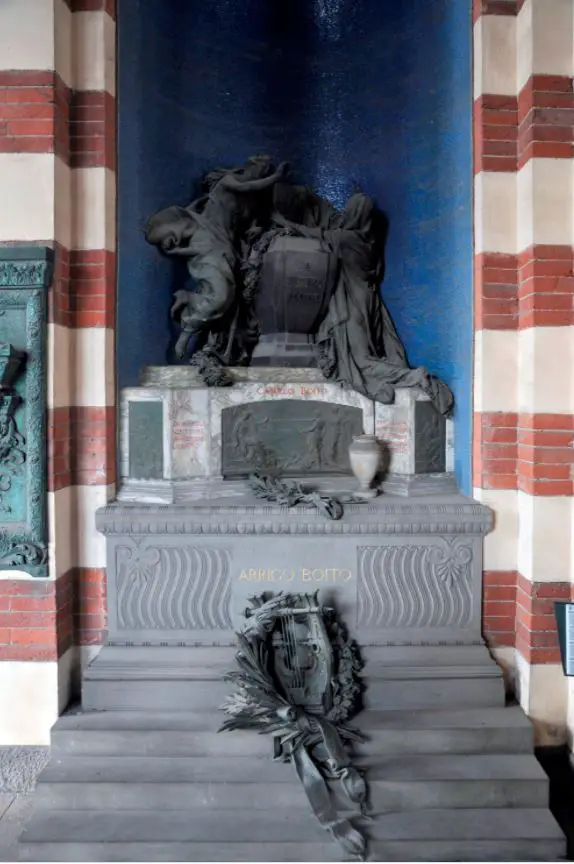
Cimitero monumentale: Franco Corelli
Corelli was a famous but controversial tenor. His powerful voice resounded in the 50s and 60s. In the link below you can hear a slow aria by Corelli, in which he offers more drama than lyricism. Nevertheless, one cannot escape the pull of this voice (Kesting speaks of a “macho magnetism”). Somewhat disturbing is the lisp, which was a negative trademark of Corelli.
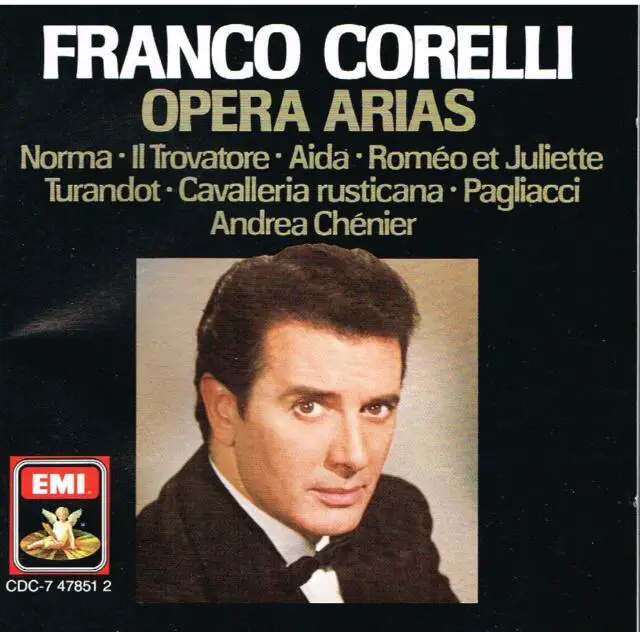
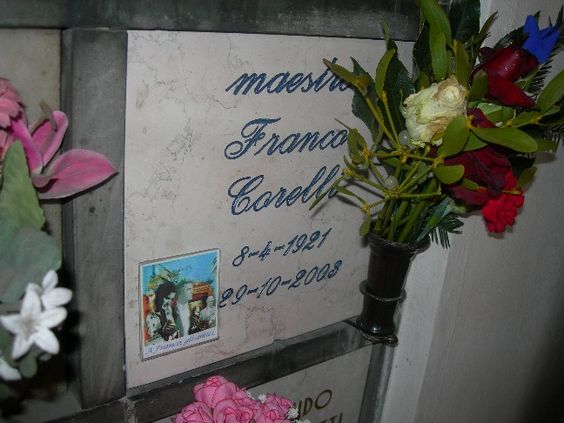
Cimitero monumentale: Amilcare Ponchielli
Ponchielli became immortal through his opera “La Gioconda” (the most famous piece from it is the “Dance of the Hours”). Later he taught at the Milan Conservatory, among his most famous students were Giacomo Puccini and Pietro Mascagni.
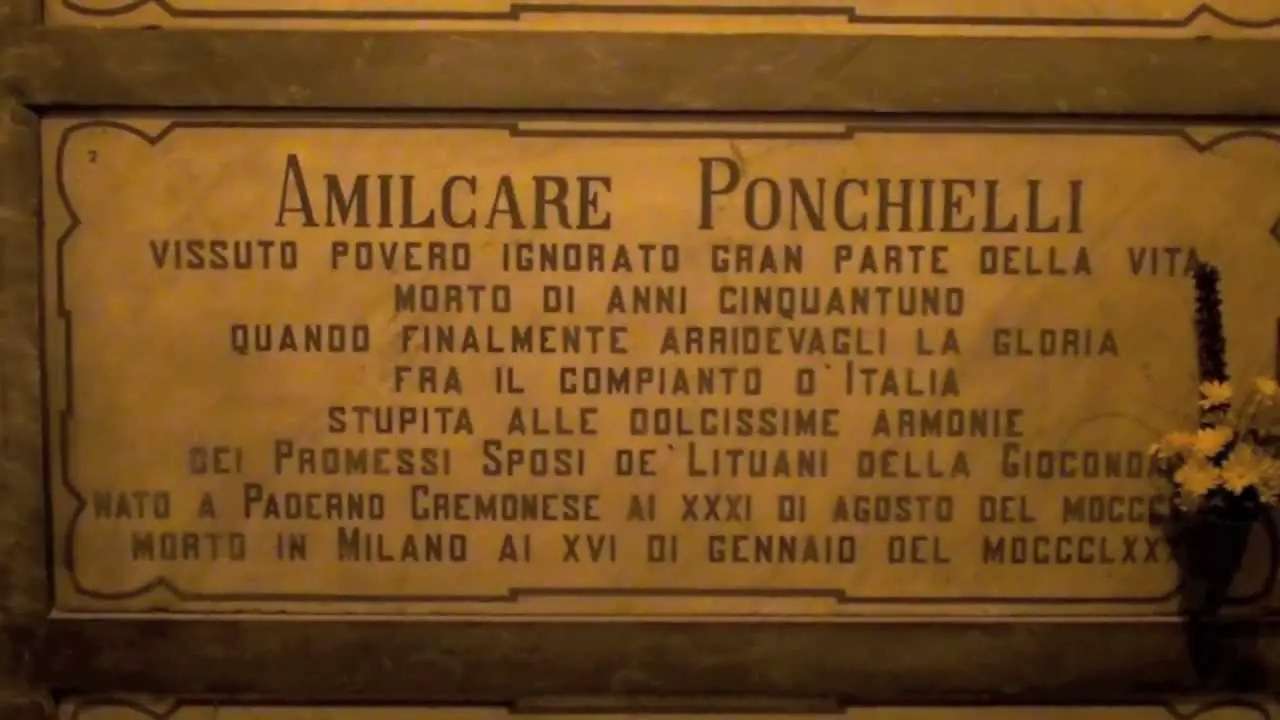

HOTELS, RESTAURANTS AND SPECIALITIES
Gran Hotel Milan (former Albergo Milano)
Two historically significant things took place in this hotel. First, it was the death house of Giuseppe Verdi, who at the end of his live permanently occupied a suite here.
Verdi Suite
Even today this suite can be booked as the “Giuseppe Verdi Suite”, it has continued to be kept as close as possible to the original décor.
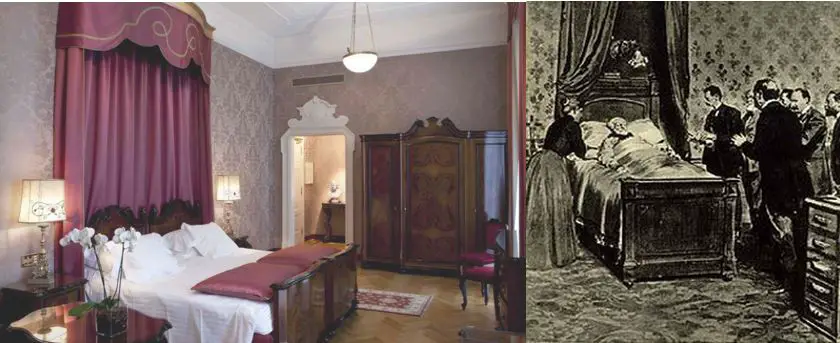
The hotel room has also become famous for the balcony that belongs to the room. Here Verdi received ovations from crowds several times. Most glamorously after the premiere of Otello, when the tenor of the premiere, Francesco Tamagno, accompanied him and the latter sang arias from Otello from the balcony to the delight of the crowd.
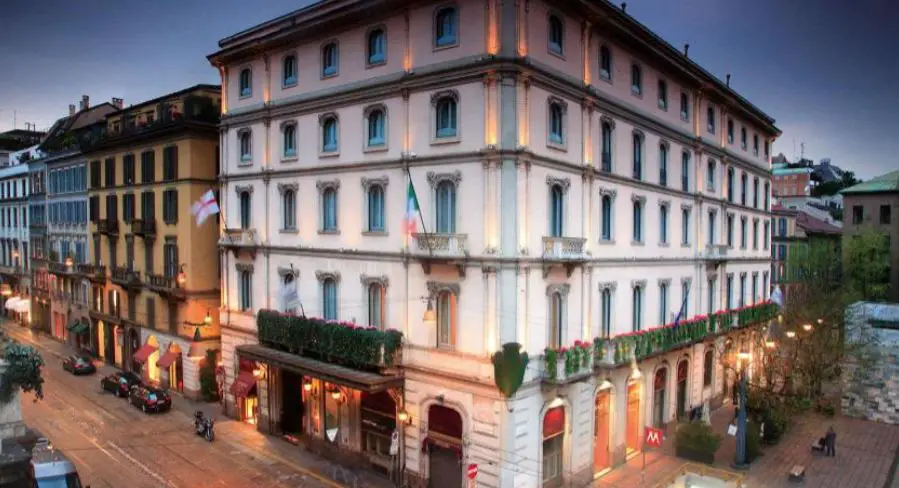
Caruso Junior Suite
Secondly, it was the place where Enrico Caruso made the legendary very first musical recordings of his voice with Fred Gaisberg. He recorded half a dozen arias, accompanied by the piano, and became the first record milionaire in history.
Suite 306, where the recordings took place, can be booked as “Enrico Caruso – Junior Suite”.
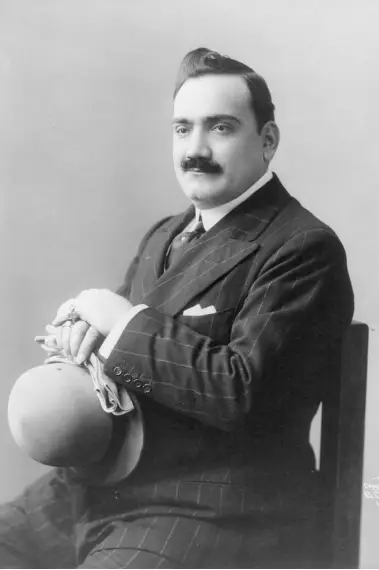
Maria Callas Suite
Maria Callas was also here. Before she moved into her apartment in Via Buonarotti, she often stayed at the Gran Hotel. There, a junior suite has been designed in her honor.
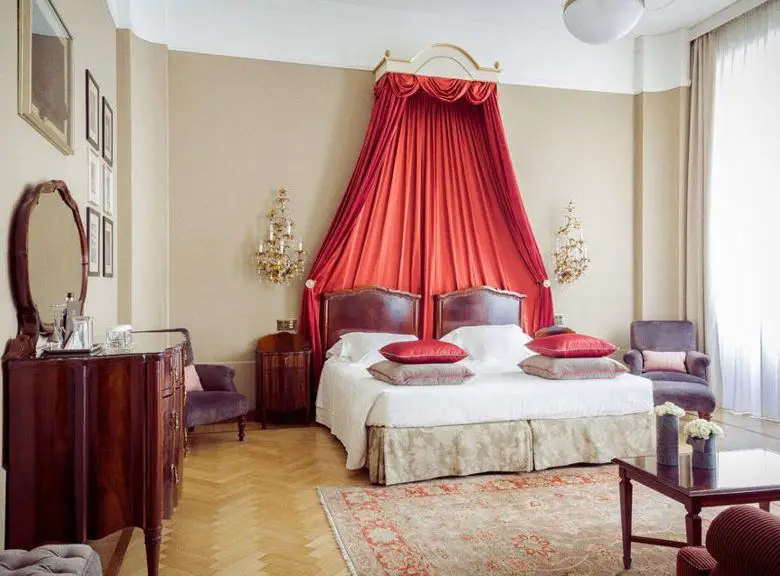
The Savini, favorite restaurant of Maria Callas
This restaurant was one of Callas’ favorite places. A place where Puccini, Verdi, Toscanini also once frequented. She liked to sit at table number 7, on the second floor, an intimate table where she could relax after the evening performances.
Savini:
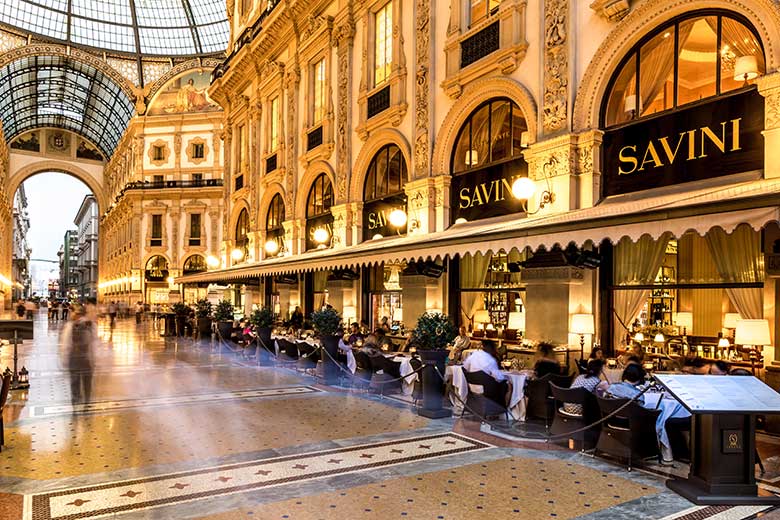
Tavolo 7 im Savini:
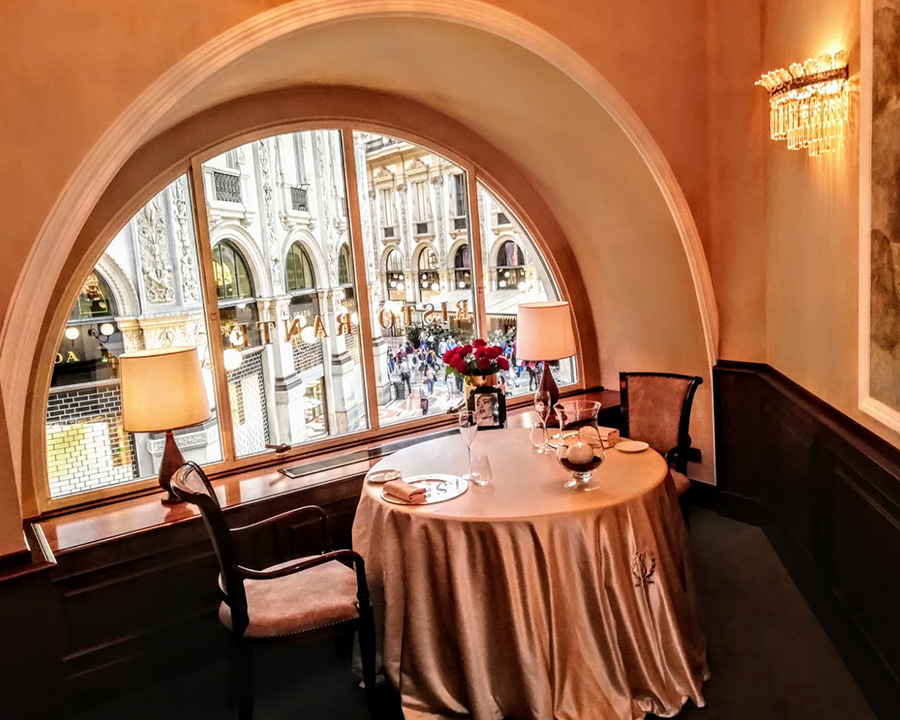
With Visconti in the Savini:
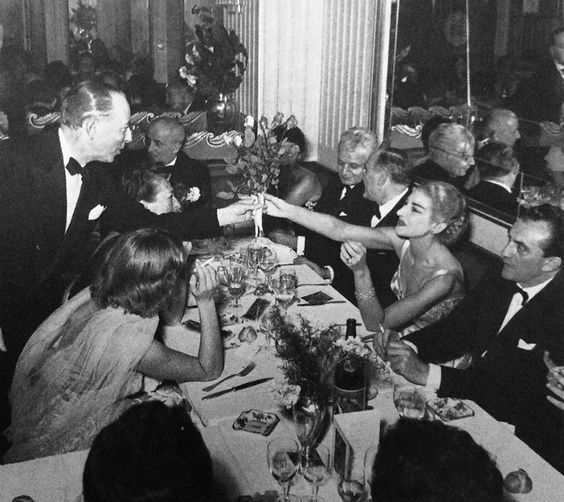
The Milanese specialty Barbajada
The Barbajada is not a place, but a product. In fact, the said, later opera impresario Domenico Barbaja had started as a waiter and discovered a product with which he became rich and in his younger years built a chain of coffee houses in Milan, immodestly giving his last name to the product: the Barbajada was born. It is a drink made of cocoa, chocolate and cream, a precursor of the cappuccino. It was popular until the thirties of the last century, but then disappeared from the coffee houses. In 2007, the Municipality of Milan included it in the De.Co list, the list of typical gastronomic products of the city, and since then you can find it more and more often. The Barbajada proudly appears on this list alongside the Minestrone alla Milanese, the Panettone, the Cassoeula, the Rostin negàa, the Mondeghili, the Costoletta alla Milanese, the Michetta di Milano, the Ossobuco Milanese and, of course, the Risotto alla Milanese.
Barbajada:

Geniessen Sie das Produkt beispielsweise in den Kaffeehäusern der Mailänder Panettone Institution Vergani.
MUSICAL PIECES WITH REFERENCE TO MILAN
Vincenzo Bellini: the fiasco of the Milan premiere of Norma
Organized claque
The premiere at La Scala in Milan was a fiasco. The performance is said to have suffered because the singers were exhausted from rehearsals, and Bellini also complained of a hostile claque. Romantic conspiracy theories even spoke of a paid intrigue by an ex-lover of Bellini’s, the Russian Countess Samoylov, who was allegedly involved with Bellini’s rival Pacini at the time. She is said to have bought an enormous number of tickets and advertisements in daily newspapers. Possibly the audience was simply surprised by the novelty of the opera. Already the second performance brought the breakthrough and Norma was performed thirty-one more times in the same season of La Scala. It quickly began its triumphal march across Europe.
Listen to the excerpt “Mira o Norma”. It is perhaps Bellini’s most beautiful and best known duet, sung by the two female voices of Norma and Adalgisa. Bellini has the orchestra play a swaying accompaniment in the first part and an intimate melody touches the listener. Then the two priestesses sing the voices with beautiful ornamentation in the enchanting interval of thirds. In the premiere, the two famous singers Giuditta Pasta and Giulia Grisi sang the two roles.
Giacomo Puccini: the fiasco of the Milan premiere of Butterfly
Puccini called the third act throughout his life “the second part of the second act”. The reason was that the premiere at La Scala in February 1904 was a fiasco. Why, is not one hundred percent clear to this day. The main reasons repeatedly cited are the unusual harmonies of the music, the (too) great length of the second act, and probably a claque of envious people wanted to harm Puccini. The failure was shameful. Puccini, who expected certain success, was in shock and had never overcome this failure. He subsequently reworked the work, among other things from a two-act to a three-act version. The success of the second performance three months later in Brescia rehabilitated the work. Nevertheless, it was reworked again for Paris in 1906, whose version is considered the final version today. For Puccini, “Madama Butterfly” was the “most soulful, expressive opera he had written”.
Hear the humming Choir, a beautiful and unusual conclusion of the second act. A choir of sopranos and tenors sing a nostalgic melody backstage at octave intervals, accompanied by a solo viola, pizzicato strings, wind instruments and the rest of the orchestra.

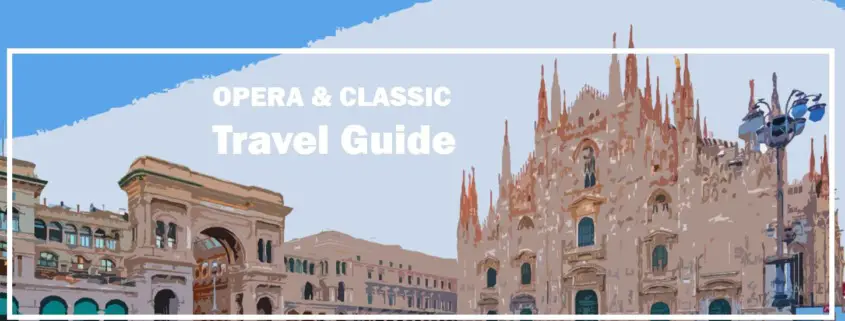


Leave a Reply
Want to join the discussion?Feel free to contribute!